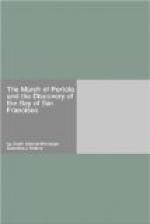The results of the expedition did not add to Vizcaino’s reputation, but he made a most glowing report of his discoveries. He told of a land double the extent of New Spain and in situation much preferable; its seas abounding in pearls of excellent quality and in fish of all kinds, in quantity greater than was contained in any other discovered sea; while in the interior of the land, some twenty days’ journey to the northwest, were people who lived in towns, wore clothes, had gold and silver ornaments, cloaks of cotton, maize and provisions, fowls of the country (turkeys), and of Castile (chickens); thus the Indians told him - not only in one place but in many. He desired permission to make another voyage, and as the late expedition had exhausted his own resources, asked that he be granted thirty-five thousand dollars from the royal treasury and outfitting for his ships. These advances he agreed to repay from the first gain received by him during the voyage. He also asked, on behalf of those who accompanied him, that the countries brought by him into subjection to the crown be given to them encomienda for five lives[3]; that they be made gentlemen and granted all the favors, exemptions, and liberties that other gentlemen enjoy, not only in the provinces of the Indies but also in Spain. For these and for other favors asked, Vizcaino agreed to sail with five ships, equipped with proper artillery, one hundred and fifty men, arms and ammunition, provisions, etc. — all things necessary for the voyage. He would pay the king one-fifth part of all gold, precious stones and valuable mineral substances obtained, one-tenth part of the fish taken, and one-twentieth part of the salt obtained. He also agreed to make discovery of the whole ensenada and gulf of the Californias, take possession of the land in the name of his majesty, make settlements, build forts, and explore the country inland for a distance of one hundred leagues.




